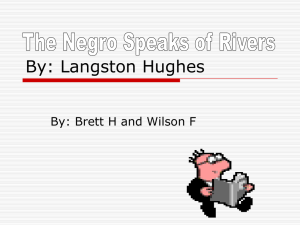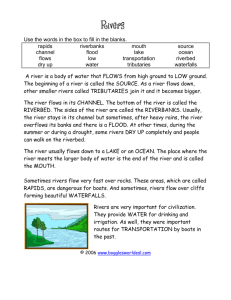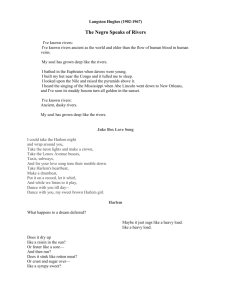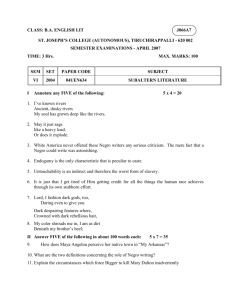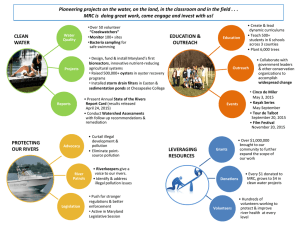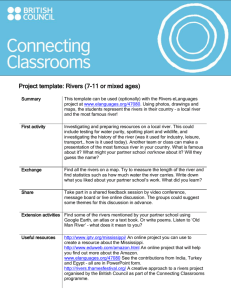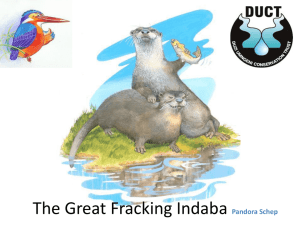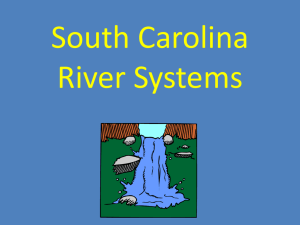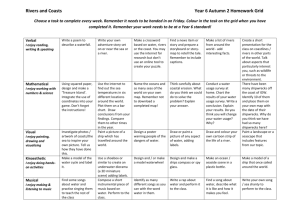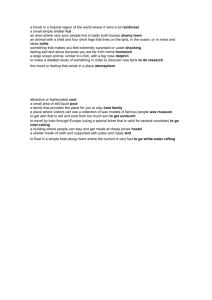All About Rivers All About Rivers
advertisement
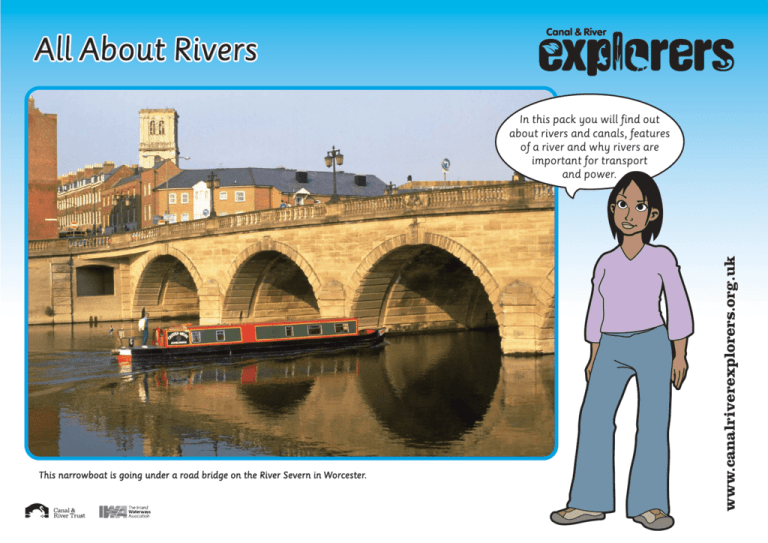
All About Rivers This narrowboat is going under a road bridge on the River Severn in Worcester. www.canalriverexplorers.org.uk In this pack you will find out about rivers and canals, features of a river and why rivers are important for transport and power. The differences between canals and rivers There are lots of different types of waterway in Britain, not just canals! You might be more familiar with rivers. Which of these are rivers? Can you spot the odd one out? All rivers are natural (they are created when rain falls in the hills and flows down to the sea.) However, some rivers have been adapted and made wider or deeper so that boats can travel up and down them. These are navigable rivers or ‘navigations navigations’. The River Avon is a well known river. Did you know that the word ‘Avon’ comes from ‘afon’ – the Welsh for ‘river’? 1 2 3 4 5 6 There are many different types of river. www.canalriverexplorers.org.uk Canals are man made, made and were built to carry goods from one place to another by boat. Answer:It is the number 6 is the odd one out. Birmingham Canal Navigation What is a river? source When rain falls on land, some water seeps into the ground, and some runs downhill. A river is a natural flow of fresh water that starts in the hills and eventually flows down to the sea. Where rivers begin is called the source. source Some rivers flow into the sea – this is called the estuary or mouth. mouth Rivers often become wider and deeper as they flow. There are three sections to a river as it flows along: the upper, middle, and lower courses. The upper course of a river is usually fast flowing, with a strong current. There might be rapids and waterfalls. The river is fastest here because middle course it has the most energy. tributaries upper course Rivers always flow downhill because of gravity. gravity lower course meander estuary or mouth The middle course is lower down the river. Here, the water flows more slowly. This is because it has less energy. The lower course of the river is when it gets closer to the sea. Here it has a lot less energy, and the water will be smoother, with no rapids or waterfalls. sea Smaller streams sometimes flow together to form larger rivers, and these small streams are called tributaries. tributaries An area can have lots of rivers which are joined together, making a river system. system The water will be smooth, with no rapids or waterfalls. It also becomes more bendy – the bends are called meanders. meanders Facts about rivers Structures like locks and weirs had to be built on some rivers so that boats could use them for transporting cargo. The River Wye has been travelled by boats since Roman times. Fishing boats, coracles (small boats for one person) and even a steam tug have travelled down the river. The River Lee has an important part to play in the Olympic and Paralympic Games. During the building of the park, 1.75 million tonnes of building materials were carried along the river by boat. Image courtesy of the Olympic Delivery Authority This is the Anderton Boat Lift near Northwich. Boats enter at the bottom and are lifted up to the top. Boats are lifted 50 feet up in the air, (more than 15 metres)! The River Lee runs through the site of the 2012 Olympic and Paralympic Games in London. The navigable River Weaver is home to the Anderton Boat Lift, which lifts boats from the river all the way up to the Trent & Mersey Canal. Image courtesy of Mike Peel www.canalriverexplorers.org.uk More river facts The Severn, Thames and Trent are the three longest rivers in Britain. The River Severn is the longest and passes through many different areas. It flows past Worcester Cathedral, and under the Iron Bridge in Shropshire. This was built in 1779. Did you know that the Iron Bridge in Shropshire was the world’s first iron bridge? This is a notice showing what you would have paid if you wanted to cross the bridge when it was built. Nowadays, people can cross for free. This is the Iron Bridge today. It was not just men and women who worked in the ironworks where it was built. Children as young as twelve would help to carry water and coal. When the Iron Bridge was built, even the royal family had to pay to go across! www.canalriverexplorers.org.uk Why are rivers important? important Water transport was much cheaper than road transport, as a horse could tow up to thirty tons on a navigable river – much more than could be carried by wagon or packhorse on roads. Rivers were often used for the carriage of heavy loose goods, or cargo, such as sand, gravel, or coal. This picture shows boats on the busy Weaver Navigation. Would you like to work on a boat like this? What are the advantages and disadvantages of carrying cargo by river instead of by road? www.canalriverexplorers.org.uk People who made their living from rivers widened and deepened them to make navigations suitable for bigger barges. Image courtesy of the Salt Museum, Northwich Settlements such as towns and cities have always developed near rivers. Rivers provided drinking water, food, transport and protection for the people living there. The Victorian River Weaver boatman Carrying goods along the river in barges provided a living for entire families. However, river boatmen often travelled without their families and were on their own for long periods of time. The men who operated the boats on the River Weaver used to go to work on a Sunday night and then stay away all week until Friday night. How would you feel about living on your own during the week? River workers It was not just the boatmen who earned a living from the river. People who owned the wharves where the cargo was unloaded could also make money from river trade, as could the owners of the pubs and alehouses where boat crews stopped for a rest along the way. Water was also diverted from the rivers to power flour mills and blacksmiths’ forges. Courtesy of Cheshire County Council Archives Boatmen took their own clothes, bedding, soap and towels. They wore clothes suitable for working: a dark jacket and trousers with a high waist held up with a belt or braces. In cold weather they might add a cap and a neckerchief. River Weaver boatmen operating the boats in Northwich. Their wives packed up food for the week in wicker baskets. They would include half a dozen eggs, a piece of cured bacon, cheese, butter, sugar and a can of condensed milk (fresh milk would have gone off as they had no fridges). They also might take a packet of tea, some tinned meat and a pot of jam. If they were lucky they had a fruit cake or some small pies. This is Tewkesbury Abbey Mill on the River Avon. Can you see the weir? A weir is a structure built to manage the flow of a river. Small dams are built across the river to change the level or direction of the water. www.canalriverexplorers.org.uk A river barge on the River Trent. These cooling towers are part of a coal fired power station in Nottinghamshire. River uses Rivers are used for water supply. supply Water is pumped out of the river, and then cleaned (purified) for use in homes and industries. In urban (city) areas, rivers are used for cooling in manufacturing processes. processes This is why large cooling towers can be seen along rivers like the River Trent. The energy in rivers is often harnessed through the use of HEP (hydro-electric hydro-electric power) power stations. This works best in mountainous areas where the river is flowing very quickly. movement) energy is produced by the Kinetic (movement river as it rushes along, and this is turned into electrical energy in the power stations. In rural (countryside) areas, rivers are also used as drinking water for livestock, such as cattle and sheep. www.canalriverexplorers.org.uk Why do rivers need to be maintained? Canals and navigations used to be maintained by separate companies, which In April 2012 British Waterways will have would charge people tolls to carry goods a new name. It will be called the on the different waterways. In 1962, Canal & River Trust which will look British Waterways was set up to run and after many canals and rivers in maintain many of the river navigations England and Wales. and canals in Britain. More flooding? In the future, climate change may have an effect on our rivers. Scientists expect there will be an increase in precipitation (rainfall). This will have an effect on the flow of rivers, and may increase flooding. This means that it is very important for our rivers to be well maintained. Many navigations are now more than 200 years old, and so need constant maintenance. Banks need to be repaired to prevent flooding, and silt and mud need to be cleared out of the waterways so that they are deep enough for boats to travel. As we manage about 2,200 miles of waterways, this is a big job! Our new charity name is Canal & River Trust A river bank is repaired on the River Avon near Saltford. The bank is strengthened with rocks and logs, and then covered in a hessian material, which plants can grow through. www.canalriverexplorers.org.uk If you want to find out more, why not visit some of the rivers that we look after? • The River Weaver, home to the famous Anderton Boat Lift. • Shardlow on the River Trent is an 18th-century shipment town with its own heritage centre. • Torksey Lock is situated where the River Trent meets the Fossdyke Navigation. The Torksey Lock interpretation centre is a great place to take part in hands-on interactive activities, and learn how a lock works. Anderton Boat Lift, Cheshire Shardlow Heritage Centre, Derbyshire Torksey Lock Interpretation Centre, Lincolnshire Always remember to stay SAFE near water – Stay Away From the Edge. If you liked this resource, why not look for more on www.canalriverexplorers.org.uk www.canalriverexplorers.org.uk
